Portal:Language

Introduction
.jpg.webp)



Language is a structured system of communication that consists of grammar and vocabulary. It is the primary means by which humans convey meaning, both in spoken and written forms, and may also be conveyed through sign languages. The vast majority of human languages have developed writing systems that allow for the recording and preservation of the sounds or signs of language. Human language is characterized by its cultural and historical diversity, with significant variations observed between cultures and across time. Human languages possess the properties of productivity and displacement, which enable the creation of an infinite number of sentences, and the ability to refer to objects, events, and ideas that are not immediately present in the discourse. The use of human language relies on social convention and is acquired through learning.
Estimates of the number of human languages in the world vary between 5,000 and 7,000. Precise estimates depend on an arbitrary distinction (dichotomy) established between languages and dialects. Natural languages are spoken, signed, or both; however, any language can be encoded into secondary media using auditory, visual, or tactile stimuli – for example, writing, whistling, signing, or braille. In other words, human language is modality-independent, but written or signed language is the way to inscribe or encode the natural human speech or gestures.
Depending on philosophical perspectives regarding the definition of language and meaning, when used as a general concept, "language" may refer to the cognitive ability to learn and use systems of complex communication, or to describe the set of rules that makes up these systems, or the set of utterances that can be produced from those rules. All languages rely on the process of semiosis to relate signs to particular meanings. Oral, manual and tactile languages contain a phonological system that governs how symbols are used to form sequences known as words or morphemes, and a syntactic system that governs how words and morphemes are combined to form phrases and utterances.
The scientific study of language is called linguistics. Critical examinations of languages, such as philosophy of language, the relationships between language and thought, how words represent experience, etc., have been debated at least since Gorgias and Plato in ancient Greek civilization. Thinkers such as Jean-Jacques Rousseau (1712–1778) have argued that language originated from emotions, while others like Immanuel Kant (1724–1804) have argued that languages originated from rational and logical thought. Twentieth century philosophers such as Ludwig Wittgenstein (1889–1951) argued that philosophy is really the study of language itself. Major figures in contemporary linguistics of these times include Ferdinand de Saussure and Noam Chomsky. (Full article...)
Selected language -
Biblical Hebrew (עִבְרִית מִקְרָאִית, (Ivrit Miqra'it) or לְשׁוֹן הַמִּקְרָא, (Leshon ha-Miqra)), also called Classical Hebrew, is an archaic form of the Hebrew language, a language in the Canaanite branch of Semitic languages spoken by the Israelites in the area known as the Land of Israel, roughly west of the Jordan River and east of the Mediterranean Sea. The term "Hebrew" (ivrit) was not used for the language in the Bible, which was referred to as שְֹפַת כְּנַעַן (sefat kena'an, i.e. language of Canaan) or יְהוּדִית (Yehudit, i.e. Judaean), but the name was used in Ancient Greek and Mishnaic Hebrew texts.
The Hebrew language is attested in inscriptions from about the 10th century BCE, when it was almost identical to Phoenician and other Canaanite languages, and spoken Hebrew persisted through and beyond the Second Temple period, which ended in the siege of Jerusalem (70 CE). It eventually developed into Mishnaic Hebrew, spoken until the fifth century CE. (Full article...)Did you know (auto-generated)
- ... that Daniel Klein's Grammatica Litvanica, the first printed grammar of the Lithuanian language, introduced the distinctive Lithuanian letter Ė?
- ... that John Hoke III, who is dyslexic and the chief design officer of Nike, has described drawing as his first language?
- ... that the name of Malaysia's Kalabakan District comes from the words "can eat" in a local language?
- ... that the programming language Acorn System BASIC was so non-standard that one commenter suggested that using it on the BBC Micro would be a disaster?
- ... that Le langaige du Bresil, one of the earliest documentary sources of any South American language, demonstrates that Europeans and Brazilian indigenous peoples maintained intimate social contacts?
- ... that Lamar Johnson learned American Sign Language for his role in the fifth episode of The Last of Us?
More did you know -
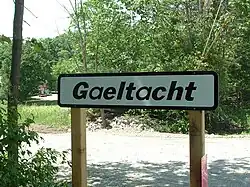
- ...that the Permanent North American Gaeltacht (pictured) is an officially designated Irish speaking area in English/French speaking Ontario, Canada, the first of its kind outside of Ireland?
- ...that Englog is English mixed with Tagalog words, while Taglish is Tagalog mixed with English words, both being macaronic languages?
- ...that some 19th-century newspapers in South Australia published articles in the Cornish dialect of English to meet the needs of miners who had migrated there?
- ...that the Halegannada, literally "old Kannada", is an ancient form of the Kannada language?
Categories
Linguistics: Computational linguistics • Grammar • Historical linguistics • Morphology • Phonetics • Phonology • Pragmatics • Reading • Semantics • Sociolinguistics • Syntax • Writing
Languages: Language families • Pidgins and creoles • Sign languages
Linguists: By nationality • Historical linguists • Morphologists • Phoneticians • Phonologists • Sociolinguists • Syntacticians • Translators
Stubs: Constructed languages • Languages • Linguists • Pidgins and creoles • Typography • Vocabulary and usage • Writing systems
Full Language category tree |
|---|
|
Select [►] to view subcategories
Language Languages Outlines of languages Language acquisition Language-related awards Language competitions Natural language and computing Language in fiction Language games Gender in language Language identifiers Language interpretation Language comparison Language movements Language preservation Language reform Linguistics Language mechanics Language and mysticism Oral communication Philology Philosophy of language Language policy Self-reference Sign language Sociology of language Language software Speech Speech and language pathology Statements Terminology Vocabulary Works about language Writing Language stubs |
Related portals
Selected topic -
Of the languages of France, French is the sole official language according to the second article of the French Constitution. French, a Gallo-Romance language, is spoken by nearly the entire population of France.
In addition to French, several regional languages are also spoken to varying degrees, such as Alsatian, a Germanic dialect (specifically Alemannic) (spoken by 1.44% of the national population); Basque, a language isolate; Breton, a Celtic language (spoken by 0.61%); Corsican, an Italo-Dalmatian language; and various other Gallo-Romance languages (Langues d'Oïl 1.25%, Occitan 1.33%). Some of these languages are also spoken in neighbouring countries, such as Belgium, Germany, Switzerland, Italy or Spain. (Full article...)Selected picture -
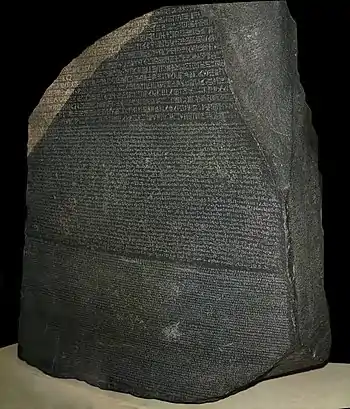
The Rosetta Stone is an ancient Egyptian granodiorite stele inscribed with a decree issued at Memphis in 196 BC on behalf of King Ptolemy V. The decree appears in three scripts: the upper text is Ancient Egyptian hieroglyphs, the middle portion Demotic script, and the lowest Ancient Greek.
Language News
- 26 July 2023 – 2023 Malian constitutional referendum
- Mali downgrades the French language from official language to working language in accordance with the new constitution. (Africanews)
Topics
Languages of Africa: Arabic, Chadic, Cushitic, Kanuri, Maasai, Setswana, Swahili, Turkana, Xhosa, Yoruba, Zulu, more...
Languages of the Americas: Aleut, Carib, Cherokee, Inuktitut, Iroquois, Kootenai, Mayan, Nahuatl, Navajo, Quechuan, Salish, American Sign Language, more...
Languages of Asia: Arabic, Assamese, Balochi, Bengali, Chinese, Japanese, Hajong, Hebrew, Hindustani, Kannada, Kokborok, Marathi, Khasi, Korean, Kurdish, Malayalam, Manipuri, Meithei, Mongolian, Persian, Rajasthani, Sindhi, Sanskrit, Sylheti, Tamil, Tanchangya, Tulu, Telugu, Tibetan, Thai, Turkish, Vietnamese, Khowar, more...
Languages of Austronesia: Austric, Fijian, Hawaiian, Javanese, Malagasy, Malay, Maori, Marshallese, Samoan, Tahitian, Tagalog, Tongan, Auslan, more...
Languages of Europe: Basque, Czech, Danish, Dutch, English (book), French, German, Greek, Italian, Latin, Leonese, Norwegian, Polish, Portuguese, Romanian, Russian, Slovak, Spanish, Ukrainian more...
Constructed languages: Esperanto, Ido, Volapük, more...
Agglutinative language, Analytic language, Constructed language, Creole, Context-free language, Extinct language, Dialect, Fusional language, Inflectional language, International language, Isolating language, Language isolate, National language, Natural language, Pidgin, Pluricentric language, Polysynthetic language, Proto-language, Sign language, Spoken language, Synthetic language, Variety (linguistics)

Applied linguistics, Cognitive linguistics, Accent (dialect), Computational linguistics, Descriptive linguistics, Eurolinguistics, Generative linguistics, Historical linguistics, Lexicology, Lexical semantics, Morphology, Onomasiology, Phonetics, Phonology, Pragmatics, Prescription, Prototype semantics, Psycholinguistics, Semantics, Stylistics, Sociolinguistics, Syntax
See also: List of linguists

Alphabets: Arabic alphabet, Bengali alphabet, Cyrillic alphabet, Hebrew alphabet, Latin alphabet, more...
Other writing systems: Abjad, Abugida, Braille, Hieroglyphics, Logogram, Syllabary, SignWriting, more..
See also: History of the alphabet, Script
Associated Wikimedia
The following Wikimedia Foundation sister projects provide more on this subject:
-
 Commons
Commons
Free media repository -
 Wikibooks
Wikibooks
Free textbooks and manuals -
 Wikidata
Wikidata
Free knowledge base -
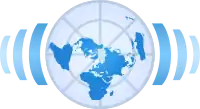 Wikinews
Wikinews
Free-content news -
 Wikiquote
Wikiquote
Collection of quotations -
 Wikisource
Wikisource
Free-content library -
 Wikiversity
Wikiversity
Free learning tools -
 Wiktionary
Wiktionary
Dictionary and thesaurus
Find a language
| Enter an ISO 639 code to find the corresponding language article |
-
 List of all portalsList of all portals
List of all portalsList of all portals -
 The arts portal
The arts portal -
 Biography portal
Biography portal -
 Current events portal
Current events portal -
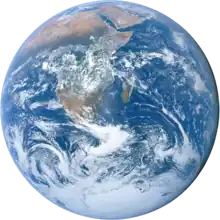 Geography portal
Geography portal -
 History portal
History portal -
 Mathematics portal
Mathematics portal -
 Science portal
Science portal -
 Society portal
Society portal -
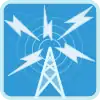 Technology portal
Technology portal -
 Random portalRandom portal
Random portalRandom portal -
 WikiProject PortalsWikiProject Portals
WikiProject PortalsWikiProject Portals

